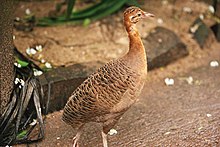
The brown tinamou is a brownish ground bird found in humid lowland and montane forest in tropical and subtropical South America.

The yellow-legged tinamou is a species of tinamou found in wooded and shrubby habitats in tropical and subtropical eastern Brazil. This superficially quail-like bird has a grey-brown plumage and two easily separated subspecies. It has declined due to human activities, and is therefore listed as Near Threatened by the IUCN.

The variegated tinamou a type of tinamou commonly found in moist forest lowlands in subtropical and tropical regions of northern South America.

The Andean tinamou is a tinamou, found commonly in high-altitude shrubland, in the Andes of South America.

The puna tinamou also known as Pentland's tinamou, is a member of the most ancient groups of bird families, the tinamous. This species is native to southern South America. The binomial name of the species commemorates the Irish natural scientist Joseph Barclay Pentland (1797–1873) by Nicholas Aylward Vigors in 1837. The IUCN list this species as Least Concern, with an occurrence range of 590,000 km2 (230,000 sq mi).

The red-legged tinamou or red-footed tinamou, is a ground-dwelling bird found in the tropics and lower subtropics of northern South America.

The solitary tinamou is a species of paleognath ground bird. This species is native to Atlantic forest of eastern Brazil.

The undulated tinamou is a species of ground bird found in a wide range of wooded habitats in eastern and northern South America.

The rusty tinamou or short-billed tinamou is a type of tinamou commonly found in swamp forest in tropical regions of South America.

The small-billed tinamou is a type of Tinamou commonly found in dry savanna in Amazonian South America.

The Tataupa tinamou is a type of tinamou commonly found in dry forest in subtropical and tropical regions in southeastern South America.

The ornate tinamou is a type of tinamou commonly found in the high altitude grassland and dry shrubland in subtropical and tropical regions of west central South America.

The brushland tinamou is a type of tinamou commonly found in high-altitude dry shrubland in subtropical and tropical regions of southern South America.

The lesser nothura is a type of tinamou found in dry grassland habitats in tropical regions of east-central South America.

The dwarf tinamou, also known as the least tinamou, is a small, superficially partridge-like bird with short tail and wings, found only in Brazil. This tinamou is the only member of the genus Taoniscus and it is considered an endangered species.

The spotted nothura is a species of tinamou. This bird is native to grassy habitats in eastern and southern Brazil, Paraguay, Uruguay, and eastern and northern Argentina.

The Chaco nothura is a type of tinamou commonly found in brushland in Argentina and Paraguay.

The quebracho crested tinamou is a species of tinamou found in dry forest habitats in Paraguay and northern Argentina in South America.

The Patagonian tinamou also known as Ingouf's tinamou is a member of one of the most ancient groups of paleognath birds, the tinamous. This species is native to southern South America.

The huayco tinamou, also known as waypu (Quechua), is a species of bird found on grassy mountain ridges in the Andes of Bolivia and Argentina.





















